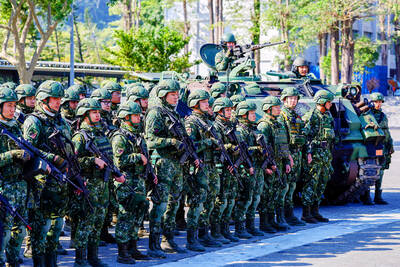President William Lai (賴清德) said that recent rapid appreciation of the New Taiwan dollar against the US dollar was primarily caused by market speculation in conjunction with Taiwan-US talks on tariffs, but his administration would safeguard national interests in negotiations.
In a recorded speech, Lai yesterday said that he regrets that market rumors have prompted the public to dump US dollars, rapidly pushing up the NT dollar on Friday and yesterday, with the local currency soaring 6.21 percent against the greenback in just two trading sessions.

Photo: Lo Pei-de, Taipei Times
Local news media cited analysts as saying that expected pressure from the US to strengthen the NT dollar largely dominated the market, as many Asian countries — including Taiwan — aim to reduce their large trade surpluses with Washington ahead of upcoming talks with the US.
Lai refuted the market rumor, saying that the latest round of bilateral trade talks did not involve currency issues.
In a statement issued yesterday, the Executive Yuan's Office of Trade Negotiation also said that the trade talks concluded on Thursday last week in Washington, the first in-person meeting on tariffs between both sides, did not include currency issues.
Taiwan's strong economic performance and healthy forecast were why the forex market expected stronger NT dollar, Lai said, citing the latest GDP data, which showed growth of 5.37 percent in the first quarter of this year, following a 4.59 percent increase last year.
The IMF even raised its forecast for Taiwan's GDP growth from 2.7 percent to 2.9 percent for this year, while downgrading its forecasts for neighboring economies such as Hong Kong, South Korea and Singapore, he said.
Lai urged Taiwanese to remain confident in the local economy, even though the impact of a stronger NT dollar might vary across industries.
Meanwhile, Lai said the large trade surplus Taiwan enjoys with the US is not related to currency, as it broadly reflects strong demand from US buyers for Taiwan-made high-tech gadgets such as semiconductors, artificial intelligence applications, and information and communications devices.
Taiwan is at a critical moment in terms of tariff talks with the US, Lai said, adding that when the government's negotiating team faces its US counterpart, Taiwanese negotiators are determined to safeguard the national interest, protect industrial development and not sacrifice any industry.
Although Taiwan was unable to isolate itself from the turbulence on global financial markets after US President Donald Trump's April 2 tariff announcement, the TAIEX, the benchmark on the Taiwan Stock Exchange has recovered and returned to 20,000 points after plunging to 17,391.76 on April 9 as foreign institutional investors resumed their buying, he said.
Taiwan has never been named a currency manipulator by the US, so the tariff talks did not touch on the currency issue, Lai said, urging people with bad intentions not to spread market rumors.
However, Taiwan was named a currency manipulator in 1988 and 1992, and last year was on a monitoring list of currency manipulation.

UNILATERAL MOVES: Officials have raised concerns that Beijing could try to exert economic control over Kinmen in a key development plan next year The Civil Aviation Administration (CAA) yesterday said that China has so far failed to provide any information about a new airport expected to open next year that is less than 10km from a Taiwanese airport, raising flight safety concerns. Xiamen Xiangan International Airport is only about 3km at its closest point from the islands in Kinmen County — the scene of on-off fighting during the Cold War — and construction work can be seen and heard clearly from the Taiwan side. In a written statement sent to Reuters, the CAA said that airports close to each other need detailed advanced

Tropical Storm Fung-Wong would likely strengthen into a typhoon later today as it continues moving westward across the Pacific before heading in Taiwan’s direction next week, the Central Weather Administration (CWA) said. As of 8am, Fung-Wong was about 2,190km east-southeast of Cape Oluanpi (鵝鑾鼻), Taiwan’s southernmost point, moving westward at 25kph and possibly accelerating to 31kph, CWA data showed. The tropical storm is currently over waters east of the Philippines and still far from Taiwan, CWA forecaster Tseng Chao-cheng (曾昭誠) said, adding that it could likely strengthen into a typhoon later in the day. It is forecast to reach the South China Sea

Almost a quarter of volunteer soldiers who signed up from 2021 to last year have sought early discharge, the Legislative Yuan’s Budget Center said in a report. The report said that 12,884 of 52,674 people who volunteered in the period had sought an early exit from the military, returning NT$895.96 million (US$28.86 million) to the government. In 2021, there was a 105.34 percent rise in the volunteer recruitment rate, but the number has steadily declined since then, missing recruitment targets, the Chinese-language United Daily News said, citing the report. In 2021, only 521 volunteers dropped out of the military, the report said, citing

WEATHER Typhoon forming: CWA A tropical depression is expected to form into a typhoon as early as today, the Central Weather Administration (CWA) said yesterday, adding that the storm’s path remains uncertain. Before the weekend, it would move toward the Philippines, the agency said. Some time around Monday next week, it might reach a turning point, either veering north toward waters east of Taiwan or continuing westward across the Philippines, the CWA said. Meanwhile, the eye of Typhoon Kalmaegi was 1,310km south-southeast of Oluanpi (鵝鑾鼻), Taiwan’s southernmost point, as of 2am yesterday, it said. The storm is forecast to move through central